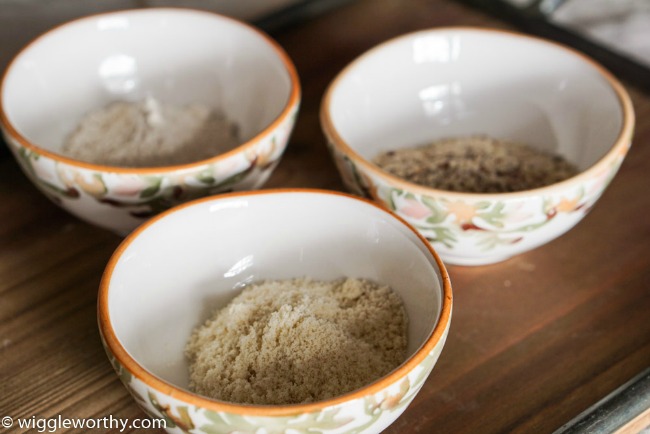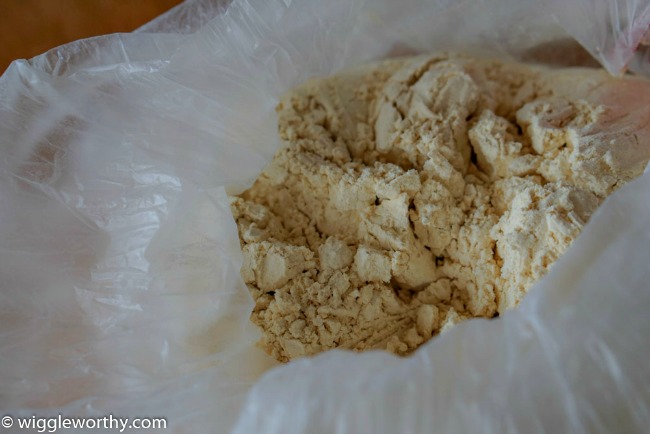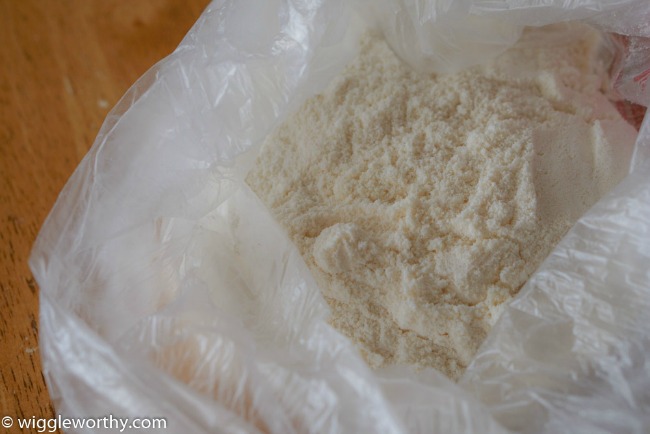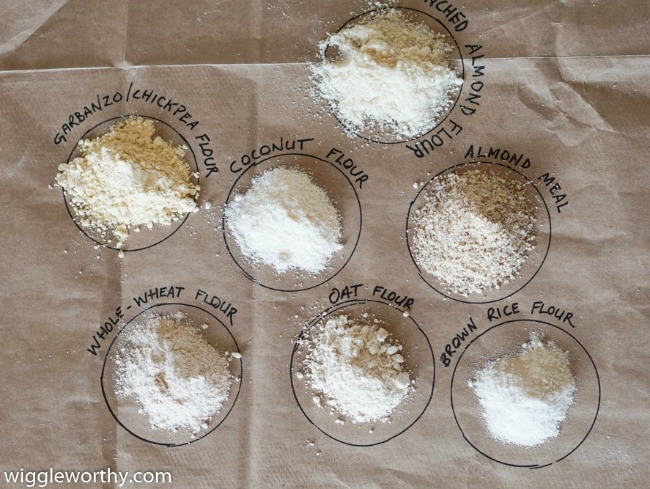Flour For Dog Treat Recipes
Choosing a flour to use in your homemade dog treat recipes might seem straightforward if you're knowledge of flours is 'white or wholewheat'.
But if you're familiar with the wide range of flour options available in most grocery stores, you might be wondering which flours are the best choices, or even which ones are safe for your dog.
The good news is that none of the flours you're likely to see on your store shelves are actually dangerous for your dog.
However, white flour is highly processed and has no nutritional value whatsoever, so please don't use that in Fido's treats.

You can use pretty much any flour when you're baking for your dog, but there are a couple of things to take into account.
First, the nutritional value of the flour itself. I know that one of the most important reasons why I make my own dog treats is because I want them to only contain wholesome, healthy ingredients. Everything that goes into one of my recipes has to have a function, and a benefit for my dogs.
Secondly, the other recipe ingredients. Each flour is a little different from the others in consistency and/or taste. When you're choosing a flour to use, think about the other ingredients' flavors and pick one which compliments them. Also, gluten free flours absorb more liquid than wholewheat so if your recipe calls for whole-wheat flour you'll need to increase the amount of liquid added, or decrease the amount of flour you use.
It's often trial-and-error when making flour substitutions in recipes but you can make things a little easier if you choose to use a gluten-free flour blend which can replace the whole wheat or all purpose flour cup for cup. You can buy these ready made, or make your own at home. When you do it yourself you can vary the flours used in an almost infinite way and allow for your dog's tastes, food sensitivities, what you have available and so on. It's actually pretty simple to do and I've explained it all in detail on this page Dog Treat Gluten Free Flour Blend, hop on over and take a look if you're interested, then come back here to keep reading.
So, which flours can you use in your dog treat recipes, what's the difference between them, and what is the best choice?
- Whole-wheat Flour
- Almond Flour
- Brown Rice Flour
- Buckwheat Flour
- Chickpea (Garbanzo Bean) Flour
- Coconut Flour
- Oat Flour
- Quinoa Flour
- Sorghum Flour
Let's take a closer look and see if I can help you find the answers to those questions.
Whole-wheat Flour
Let's start with whole-wheat flour because it's the most well-known flour (next to white) and easy to find in any store. It's also the only flour on this page which is NOT gluten-free, so it gets a category all to itself.
Whole-wheat flour is a perfectly good choice for homemade dog treat recipes, and a popular one too. It also contains a protein called gluten, which can be a trigger for allergies in some dogs (and people of course). Obviously if you know that your dog has a grain intolerance you want to go for a gluten-free option!
A few common signs that a dog may have a problem with gluten or grain products include skin irritation/inflammation/hot spots, recurring ear infections or chronic digestive upsets like diarrhea or vomiting.
This flour is made by grinding up the whole wheat kernel, meaning that every part of the grain is used and the flour retains the full nutritional value.
Whole-wheat flour is a good source of a range of vitamins, minerals, antioxidants and plant based nutrients. These include Vitamin B9 (folate), Vitamin E, copper, iron, manganese and selenium, It's also high in fiber and carbohydrates.
Whole-wheat flour makes dough a little stickier than if you were using white (processed) flour but if you're substituting whole-wheat for white and are finding the dough a little difficult, just add a touch more flour to the mix. You can also use flour liberally on your work surface and rolling pin.
Whole-wheat flour has a slightly nutty flavor and adds texture to your dough, it also gives your treats a lovely golden brown color. It's very versatile and is perfect for both sweet and savory dog treats.
So, bottom line is don't be afraid to use whole-wheat flour in your homemade dog treats as long as your dog doesn't show any signs of gluten intolerance.
It's always a good idea to vary your dog's diet so that he gets a full range of nutrients, the same goes for his treats.
Switch up ingredients and recipes (including the flours you use if you want to) so that Fido's treats provide a balance of nutrients.
How to store Whole-Wheat Flour (and other wholegrain flours)
Whole grain flours have a higher fat content than white or highly processed flours, this means that their shelf-life is more limited. Whole-wheat flour should be fine in your cupboard or larder for three or four months. If you want to keep it for longer than that put it in the refrigerator or freezer.
Gluten-Free Flours
If your dog has an intolerance, or allergy, to wheat or grain, or you'd rather avoid grains for other reasons, then using a gluten free flour is the way to go.

Gluten free flours don't 'perform' in the exact same way as whole-wheat or white flours. They absorb less liquid, don't contribute to 'rising' (if you're making dog-friendly cup cakes for example) and tend to produce a heavier, denser treat.
Check out my tips on substituting one flour for another to learn more about the adjustments you will need to make.
There is some practice needed to get familiar with gluten-free baking, and if you're new to these flours I'd suggest starting out with recipes which include the flour of your choice rather than trying to make a substitution right off the bat.
Here are the most popular gluten free flours for use in dog treat recipes:
Almond Flour
Almond flour is a gluten-free flour made from finely ground, blanched, skinned almonds. It's low in carbohydrates, high in plant-based protein, and a good source of polyunsaturated fats (aka macronutrients). It's also cholesterol free.
Some of the nutrients from almonds are in the skin and these are lost during the processing of almond flour, but the nuts themselves contain several vitamins and minerals (aka micronutrients) including Vitamin E, calcium, iron, magnesium, manganese, zinc and potassium.
Almond meal is a coarser grind of almonds, and can be made from blanched almonds, or unblanched (the skin is left on). It has a nuttier texture and flavor than fine-ground almond flour made from blanched almonds. It will produce
Check the label and consistency/appearance of almond flour before you buy because labeling isn't consistent and some manufacturers call their almond meal almond flour. It can get confusing.
Almond meal can cause problems with some dog treats and cakes not holding their shape properly, or rising adequately, when baking.
Substituting nut flours for wheat or other types of flour can be tricky, as the other ingredients need to be adjusted, sometimes significantly. Either use recipes which specifically call for almond flour, or be prepared for some trial-and-error to begin with. Not that your dog will mind eating the treats which don't work out... they'll probably taste equally delicious to him!
Almond flour works well in both sweet, and not-so-sweet recipes.
How to store Almond Flour (and other nut flours)
Because Almond flour is a nut flour it has a fairly high oil content and that means it will spoil more quickly than many other types of flour. It's best to keep nut-based flour in an airtight container in the refrigerator or freezer. Even then they have a reasonably limited shelf-life at around six months in the fridge and a year in the freezer. Allow flour to defrost and/or reach room temperature before using.
Brown Rice Flour
Brown rice flour is made by grinding unhulled (whole grain/unrefined) brown rice. It's a gluten free flour which is high in fiber and contains calcium, zinc and folate.
Brown rice has a slightly gritty texture which can also be seen in the treats you make with it. It also tends to produce a heavier, more dense dough. This will affect the consistency of the dog treats when baked and makes it more suitable for some recipes than others.
Mixing brown rice flour with another gluten free flour such a sorghum flour (25% brown rice flour:75% sorghum flour) or oat flour helps to reduce this grittiness and lighten the end results.
You can also buy white rice flour. It's made by grinding hulled rice, this means it has less nutritional value than brown rice flour.
White rice flour is much finer in texture and your treats will be lighter than if you use brown rice flour. It can also be directly substituted for whole wheat flour in recipes. However, bear in mind if you do this you get the gluten-free benefit (if your dog has gluten issues) but you lose the nutritional value. Mixing both white and brown rice flour is better than simply using the white variety if you want to go this route when making dog treats.
Brown rice flour is a good choice for savory dog treat recipes.
Buckwheat Flour
In spite of it's name, Buckwheat flour is not derived from grain, but from the seed of plant originally found in Asia. It can be found in three different varieties, light, medium and dark. The more complete the seeds used to produce the flour, the darker the color and the higher the nutrient value.
Buckwheat flour which is made using the whole seed is gluten free and packed full of vitamins and minerals (micronutrients) including Vitamin B6, copper, folate, manganese, magnesium, niacin, phosphorous, potassium and zinc. It's also high in plant-based protein and contains a healthy dose of antioxidants and fiber.
Like brown rice flour, the darker buckwheat flour may have a gritty texture. It also has a slightly bitter taste. Mixing dark buckwheat with another gluten free flour (such as coconut flour or oat flour) can help minimize both of these. Or try mixing light and dark buckwheat flour as the lighter version is milder and bakes up lighter. Again, trial and error is likely to be a factor when substituting with buckwheat flour in your homemade dog treat recipes.
Buckwheat flour has a fairly bold, nutty taste. It can work well in both savory and sweeter dog treat recipes.
Buckwheat flour needs to be stored in the refrigerator in an airtight container.
Chickpea Flour (aka Garbanzo Bean Flour)
Chickpea flour is made from dried, ground chickpeas (roasted or raw). Varieties made from roasted chickpeas have a stronger flavor, while those made from raw chickpeas can be a little bitter. You can pretty much use either in your recipes without any noticeable difference.

It's one of the most nutrient-dense gluten free flours and is high in plant-based protein (contains double the amount of protein as whole wheat flour) and fiber, while low in carbohydrates.
Packed full of vitamins and minerals including Vitamin B6, B9 (folate), iron, manganese, magnesium, potassium, selenium and zinc.
The most even substitution with another gluten free flour is to use coconut flour. It's pretty much a 1:1 exchange. Or you can use a blend of both when creating dog treats or cakes.
Coconut Flour
Coconut flour is made from ground coconut meat (that's the white part of the coconut). It's a minimally processed low carb, gluten-free flour which is high in plant-based protein and even higher in fiber. Depending on the composition of any particular flour, the fiber content of coconut flour can be between 35% and 60%. Fiber slows sugar absorption and coconut flour can lower blood sugar levels, for at least a few hours after eating it.
Coconut flour may, or may not, have a slight coconut flavor. Pure, organic coconut flour is the most likely variety to be flavorless in this respect.
Coconut flour contains a range of vitamins and minerals including vitamin B6, folate (vitamin B9), vitamin C, niacin, calcium, potassium, phosphorous, manganese and selenium. It's also a rich source of amino acids.

Coconut flour is VERY absorbent (absorbing up to four times it's own weight in fluid) and if you're using coconut flour instead of whole-wheat in your dog treat recipes then you'll need to increase eggs and/or oil, and other liquids to get the dough to the right consistency. If your dog isn't gluten-intolerant try mixing coconut flour with whole-wheat in a 2:1 ratio to compensate for it's absorbency.
As many coconut flours do have a slight coconut-y taste, it's a good choice for sweeter dog treats, especially those using fruit.
Oat Flour
Oat flour is simply finely ground oats and is a nutritious, gluten-free, high carbohydrate, low sugar flour that is easy on most dog's digestive systems.
Oat flour is an excellent source of a range of essential antioxidants (some that are unique to oats), vitamins and minerals including Vitamin B1, B6, Copper, Folate, Iron, Manganese, Magnesium, Niacin, Phosphorus, Selenium and Zinc.
Oat flour retains moisture more than whole-wheat flour and treats may come out more moist because of that. It's also a good choice to lighten up the recipes which contain other gluten-free flours by replacing 1/4 of the flour called for with oat flour.
How to Store Oat Flour
Oat flour will stay fresh in a cool, dry cabinet or larder for around three months if it's in an airtight container. For longer storage put it in the refrigerator (will stay fresh for up to about four months), or wrap tightly and pop it in the freezer where it will be fine for six months, or longer.
Quinoa Flour
Quinoa flour is, in my opinion, a debatable choice for dog treat recipes, or dog food in general. It's a gluten-free, grain free flour made from finely ground quinoa seeds.
Quinoa flour is a good source of a range of minerals including Copper, Folate, Iron, Manganese, Magnesium, Phosphorous and Zinc. It also contains all nine essential amino acids which are important for health.
This flour has a strong, earthy taste and would be most suitable for savory dog treat recipes.
The quinoa plant naturally produces a chemical called Saponin (to protect itself from insects and fungal growth) and some of this compound remains present in quinoa flour. Some experts believe this can cause irritation and inflammation of the gut in certain people, and dogs. Others don't agree, and evidence either way is scarce. Quinoa and quinoa flour can also be a little difficult for some dogs to digest.
As there are many great gluten-free flour options for baking, I personally choose not to use quinoa flour until the research is definitive, one way or the other. But do your own research and make a decision based on that, there are plenty of dog owners who are very happy to use quinoa flour in their recipes both for themselves and their dogs, it's a personal choice.
Sorghum Flour
Sorghum flour is made from finely ground whole grain sorghum, it's naturally gluten free and is considered an 'ancient grain'.
It's a good source of plant-based protein, rich in antioxidants and also contains a range of vitamins and minerals including B vitamins, niacin, Iron, Magnesium, Phosphorous and Potassium.
If your dog has generalized grain sensitivities then sorghum flour isn't for him. If it's just gluten he has issues with then it might be, but make sure that the flour you buy has been processed in a gluten-free facility.
You can substitute sorghum flour for whole-wheat flour in your recipes at a 1:1 ratio, BUT as this is a grain free flour you need something extra to help bind the other ingredients. Egg whites or corn starch make good binder. Or, mix sorghum flour with wholewheat flour if your dog isn't gluten intolerant.

You Might Also Like These pages...
- Home
- Dog Treat Ingredients
- Flour for Dog Treat Recipes


